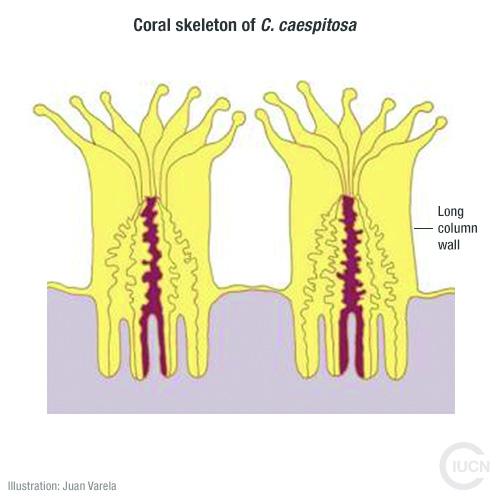Oculina patagonica
Information
The colonies are generally encrusting, thicker in the centre with a thin edge spreading over the substrate. However, the form of the colony varies with depth and other characteristics of the environment. Bleaching of O. patagonica may be seen at some sites, starting on the outer edges of the colony and spreading inwards.
It is an opportunistic species, able to thrive in various littoral habitats, encrusting on vertical and horizontal surfaces in natural pristine sites as well as in marinas, harbours and heavily polluted areas.
It is able to reproduce both sexually by broadcast spawning and asexually by budding new polyps from existing ones, resulting in crowded, genetically identical colonies. Its successful proliferation is also due to its early reproductive maturity and high growth rate.
Oculina patagonica resembles the native scleractian coral Cladocora caespitosa. The calcareous colonies of C. caespitosa are, however, globular, homogeneous and sometimes more than 50 cm in diameter.
Colonies of O. patagonica are more low-growing and encrusting and have connective tissue between the polyps that makes the shape of the skeleton readily apparent.



The origin of this species is uncertain. It is perhaps from South America: northern Argentina and southern Brazil. Previously unknown in the Mediterranean, specimens were tentatively identified as Oculina patagonica in 1908 and regarded as a species accidentally brought into the Mediterranean by shipping from the temperate south-western Atlantic. It has now been recorded in Italy, Spain, France, Turkey, Lebanon, Israel, Egypt, Tunisia and Algeria.
The increase of this opportunistic species may affect the stability of algal communities as the dominant trophic group on shallow rocky Mediterranean substrates. It overgrows calcareous structures such as serpulid worm tubes, vermetid shells and barnacles, and can completely eliminate algae and other soft-bodied attached organisms. It also out-competes the indigenous Cladocora caespitosa, which is overgrown when the two species come into contact.
Unknown.
Sartoretto S., et al., 2008. The alien coral Oculina patagonica De Angelis, 1908 (Cnidaria, Scleractinia) in Algeria and Tunisia. Aquatic Invasions Vol 3, Issue 2, 173-180.
Coma R., et al., 2011. Sea Urchins Predation Facilitates Coral Invasion in a Marine Reserve. PLoS ONE 6(7): e22017. doi:10.1371/journal.pone.0022017.
Fine M. , Zibrowius H., Loya Y., 2001. Oculina patagonica: a non-lessepsian scleractinian coral invading the Mediterranean Sea. Marine Biology 138, 1195-1203.




